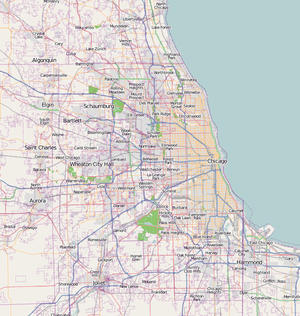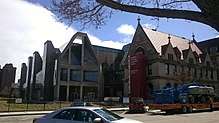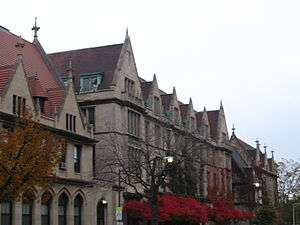University of Chicago Laboratory Schools
The University of Chicago Laboratory Schools (also known as Lab or Lab School and abbreviated UCLS; the upper classes are nicknamed U-High) is a private, co-educational day school in Chicago, Illinois. It is affiliated with the University of Chicago. Almost half of the students have a parent who is on the faculty or staff of the University.[3]
| The University of Chicago Laboratory Schools | |
|---|---|
 | |
| Address | |
 The University of Chicago Laboratory Schools  The University of Chicago Laboratory Schools  The University of Chicago Laboratory Schools | |
1362 E. 59th St. , United States | |
| Coordinates | 41.7886°N 87.5940°W |
| Information | |
| Type | Private Secondary |
| Established | 1896 |
| Founder | John Dewey |
| Director | David Magill (interim director) |
| Grades | Nursery (age 3)–12 |
| Number of students | 2,161 (2018–19)[1] |
| Nickname | Maroons |
| Newspaper | U-High Midway |
| Yearbook | U-Highlights Yearbook |
| Tuition | 2020-21: Nursery, Half Day - $23,879 Nursery, Full Day-Grade 5 - $33,192 Grades 6-8 - $35,442 Grades 9-12 - $36,933[2] |
| Website | www.ucls.uchicago.edu |
History
The Laboratory Schools were founded by American educator John Dewey in 1896 in the Hyde Park neighborhood of Chicago. Calvin Brainerd Cady was director of the music department under Dewey.[4] The school began as a progressive educational institution that goes from nursery school through 12th grade. This experiment was an integral part of the University of Chicago during the years 1896 to 1904, and was an undertaking which aimed to work put, through the University, a school system which should be an organic whole from the kindergarten to the university. Conducted under the management and supervision of the University's Department of Philosophy, Psychology, and Education, it bore the same relation to the work of that department that a laboratory bears to biology, physics, or chemistry. Like any such laboratory it had two main purposes: (1) to exhibit, test, verify, and criticize theoretical statements and principles; and (2) to add to the sum of facts and principles in its special line. For it was part of the philosophical and psychological theory he entertained that ideas, even as ideas, are incomplete and tentative until they are employed in application to objects in action and are thus developed, corrected, and tested. The need of a laboratory was indicated. John Dewey, when called to be the head of the department in 1894, had arrived at certain philosophical and psychological ideas which he desired to test in practical application. In consequence, it was labeled as the Laboratory School (Mayhew & Edwards, 1966).
Campus
The Laboratory Schools consists of two interrelated campuses. The Historic Campus, located at 1362 East 59th Street, fills two full city blocks. It houses grades 3–12 (about 1,200 students) in five connected buildings: Blaine Hall (built in 1903), Belfield Towers (1904), Judd Hall (1931), the high school (built in 1960), the middle school (1993), and Gordon Parks Arts Hall (2015) which has 100 classrooms. Two connected gymnasiums also sit on this campus, Sunny Gym (built in 1929) and Kovler Gymnasium (built in 2000) and students have access to both Scammon Gardens and Jackman Field.
In September 2013, Lab opened Earl Shapiro Hall on its new Early Childhood Campus located at 5800 S. Stony Island Avenue. This new building, designed by Valerio Dewalt Train and FGM Architects, is home to approximately 625 children in nursery through second grade. The building is named for Earl Shapiro, who graduated from Lab in 1956.
Student body and academics

The school has over 2,160 students in Pre-Kindergarten – Grade 12.
Today the school is divided into a Nursery School (Pre-K and Kindergarten), Primary School (grades 1 and 2), Lower School (grades 3 through 5), Middle School (grades 6 through 8), and High School (grades 9 through 12). Many children begin in nursery school and continue through their high school graduation, and 75% of applications are for nursery school or 9th grade. The student/teacher ratio is 8:1.[5]
The school was ranked fourth in the nation for its record of sending graduates to elite universities and colleges.[6] From 2012–2016, some of the colleges at which U-High students matriculated were: University of Chicago (71 students), New York University (20 students), Northwestern University (19 students), Yale University (15 students), Stanford University (11 students), Massachusetts Institute of Technology (9 students), Brown University (9 students), Johns Hopkins University (9 students), Princeton University (7 students), Columbia University (7 students), Harvard University (3 students).
U-High offers more than 150 different classes. All are college preparatory in nature and there are 22 Advanced Placement or Advanced Topic courses. High school students may also take classes at the University of Chicago at no extra charge, and about 20 do so each year. The average composite ACT score is 31.5.[7] The school maintains four separate libraries[8] which collectively hold over 110,000 volumes.
Extracurricular activities
High school students may choose from 40+ different clubs and activities. The high school math, science, and Model UN teams are regular contenders for – and winners of – state titles. The school's newspaper (The Midway) and the yearbook (U-Highlights) regularly win regional and national awards, as does its arts magazine, Renaissance. Other popular activities include theater, ethnic clubs, Student Council, policy debate, and Model UN. The Model UN team is consistently ranked among the top in the nation, and is world-renowned for its competitive excellence.[9] In 2011, it was ranked the #2 High School Model UN team in the United States.[10] In 2018, Lab's Model UN team won the Best Large Delegation award at the Harvard Model UN conference. In addition, the Debate Team has won numerous national circuit tournaments, and is unofficially considered to be in the Top 20 nationwide. Furthermore, U-High's Math and Science teams consistently win and place at Regional and State competitions, respectively.
Organized by the Office of Alumni Relations Development, members of the student body at U-High are nominated by faculty to serve in the Maroon Key Society. The Maroon Key Society serve as[11] ambassadors for the school, and they help provide tours to visiting alumni, potential students, and other guests to the school.
The school's athletic teams, the Maroons, compete in the Independent School League (ISL) and are members of the Illinois High School Association (IHSA). The middle school fields 15 teams in baseball, basketball, cross country, soccer, track, and girls volleyball. The high school has more than 25 teams: baseball, basketball, cross country, fencing, golf, squash, sailing, soccer, swimming, tennis, indoor and outdoor track & field, and girls volleyball. All operate with a "no cut policy," meaning any student who wishes to participate may, and nearly 65% of U-Highers participate on at least one team.
The high school's extracurricular activities occasionally make national and international news. For example, in 1990 then-Governor Thompson declared a "Matthew Headrick Day"[12][13] and the US House made a proclamation[12] when then-student Headrick appeared on talk shows including Today[12][14] after winning the Westinghouse.[15][16] In response to the award, the Chicago Tribune wrote: "this ... is a ... school where being on the math team ... can actually enhance one's social status."[17] The Tribune's coverage was controversial because, as noted previously, U-High's extracurricular activities, including the math team, operate on a "no cut policy," and therefore participation was unlikely to confer social status. The faculty responded by posting a banner that humorously read: "The Few. The Proud. The U-High Math Team. Conferring social status since 1990."[18]
Notable alumni and people

Notable teachers
Here are a few of the teachers who have worked at Lab:
- Eight Lab teachers have received Chicago’s prestigious Golden Apple Award—more than from any other school in the city. (2009 Christina Hayward; 2007 David Derbes; 2004 Rosa McCullagh; 1994 Michael (Spike) Wilson; 1992 Jan Yourist; 1989 Catharine Bell; 1987 Hanna Goldschmidt; 1986 Randy Fowler.) Others have received the Kohl McCormick Early Childhood Teaching Award.
- A MacArthur “genius” award and the Erikson Institute Award for Service to Children are among the achievements of author/teacher Vivian Paley, who spent most of her career at Lab. (Lessons from her acclaimed book You Can’t Say You Can’t Play shape Lab’s approach.)
- Created and funded in honor of Zena Sutherland (a former U. of C. faculty member and still considered among the world’s most influential scholars of young people’s literature), the annual Sutherland Award for Excellence in Children’s Literature is one of the only student-selected book awards in the United States.
- Lab teachers contributed to the University of Chicago School Mathematics Project, the largest university-based mathematics curriculum project in the country. Their results included the nationally acclaimed Everyday Mathematics texts for elementary school students and Transition Mathematics, a middle school pre-algebra text.
- Blue Balliett, author of Chasing Vermeer, The Wright Three, and The Calder Game, based her children’s mysteries on her experiences teaching students at Lab.
Classrooms
Lab classrooms are visited by teachers and administrators who wish to experience the way Lab teachers integrate Dewey’s philosophy into their classroom experience.
References
- "Facts at a Glance – University of Chicago Laboratory Schools".
- "Tuition – University of Chicago Laboratory Schools".
- "FAQs – University of Chicago Laboratory Schools". www.ucls.uchicago.edu. Retrieved 2019-05-22.
- Shiraishi, Fumiko. "Calvin Brainerd Cady: Thought and Feeling in the Study of Music." Journal of Research in Music Education; Summer 1999; 47, 2; ProQuest Research Library. 150.
- "Facts at a Glance – University of Chicago Laboratory Schools". www.ucls.uchicago.edu. Retrieved 2019-05-22.
- The Wall Street Journal, "How the Schools Stack Up," http://online.wsj.com/public/resources/documents/info-COLLEGE0711-sort.html
- http://www.ucls.uchicago.edu/data/files/gallery/ContentGallery/HS_Profile_201314hires1.pdf
- "Libraries – University of Chicago Laboratory Schools".
- The Diplomat, Issue #335, May 5, 2010, University of Chicago Press.
- America's Best High School Model UN Teams: 1-5. Best Delegate, http://bestdelegate.com/fall-2011-high-school-model-un-rankings-top-1-5/
- Knoll, M. (2014) Laboratory School, University of Chicago. In D. C. Phillips (ed) Encyclopaedia of Educational Theory and Philosophy, Vol. 2 (London: Sage), pp. 455–458.
- "Students Hail The Conquering Scientist". tribunedigital-chicagotribune. Retrieved 2015-10-29.
- "Illinois Register, 14: Issue 45 – November 9, 1990, Volume 14, Page 106 | Document Viewer". Mocavo. Retrieved 2015-10-29.
- Gumbel, Bryant (March 7, 1990). "Westinghouse Science Project Winners Discuss Their Project (audiovisual file)". NBC News Today Show. Today New York Studio. Retrieved 2015-10-30.
- "EDUCATION; From Nitrogen Fixation To a $20,000 Scholarship". The New York Times. 1990-03-07. ISSN 0362-4331. Retrieved 2015-10-29.
- "All Students Need State-of-the-art Science Education". tribunedigital-chicagotribune. Retrieved 2015-10-29.
- "Teenage Science Whiz Captures A National Honor". tribunedigital-chicagotribune. Retrieved 2015-10-29.
- "Westinghouse Competition Media Coverage". U-High Midway Student Newspaper. March 1990.
- Knoll, M. (2014) Laboratory School, University of Chicago. In D. C. Phillips (ed) Encyclopaedia of Educational Theory and Philosophy, Vol. 2 (London: Sage), pp. 455–458.
- University of Chicago's Facilities Service Website
External links
- Official website
- 100 Years of Learning at The University of Chicago Laboratory Schools
- Guide to the University of Chicago Laboratory Schools Records 1891-1986 at the University of Chicago Special Collections Research Center
- Guide to the University of Chicago Laboratory Schools Work Reports 1898-1934 at the University of Chicago Special Collections Research Center